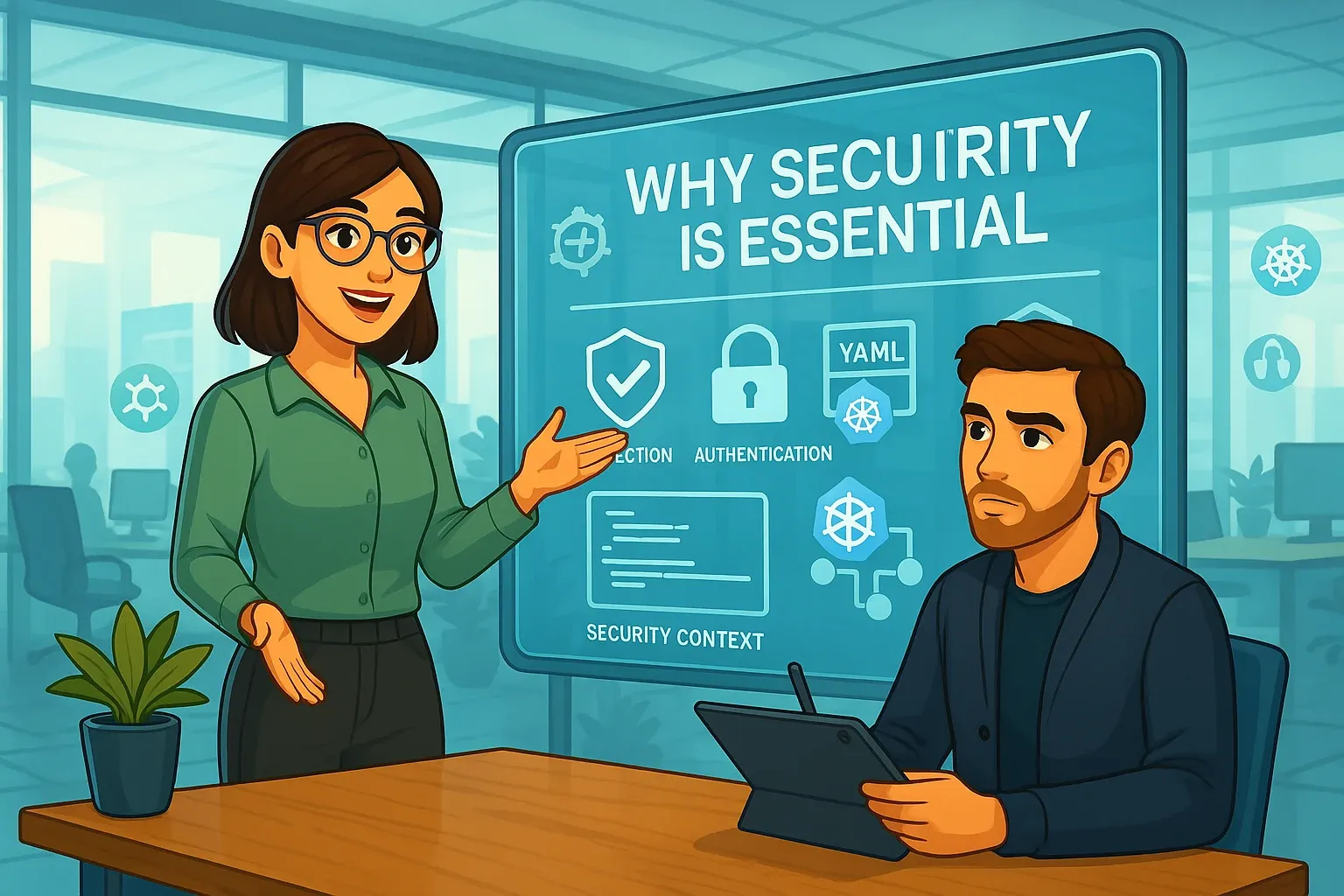Bob's Kubernetes Journey Begins: Why Security Is Essential
Bob's journey takes him into the world of Kubernetes, where Josie guides him through the essential components and security practices. Together, they tackle the challenges of container orchestration, learning why security must be at the core of every Kubernetes deployment.

Bob, now a seasoned Docker captain, was steering his containerized applications confidently. He had mastered the art of building secure images, minimizing attack surfaces, and ensuring image integrity. But as his applications grew, he felt the need for a more robust ship to navigate the vast sea of containers. Enter Kubernetes.
As he stood at the helm of his container ship, Bob found himself at a crossroads. His journey had taken him far, but there were new challenges on the horizon. Josie, a Kubernetes expert and his trusted mentor, nudged him toward Kubernetes. With a knowing smile, she reminded him, “Security is crucial here, Bob. It's not just about mastering the tools but about securing every step along the way.”
Why Kubernetes?
Bob's "aha!" moment came when he was deploying a new microservices application. Managing multiple containers, their dependencies, networking, and scaling was becoming a complex juggling act. He needed a container orchestrator, and Kubernetes, the renowned maestro of the container world, seemed like the perfect fit.
Kubernetes promised to simplify container management, automate rollouts and rollbacks, and provide self-healing capabilities. But Bob quickly realized that with great power comes great responsibility, especially in the realm of security.
Kubernetes Essentials
Before diving into security, Bob needed to grasp the basics of Kubernetes. He learned about its core components:
- Deployment
- Pods
- Containers
- Services
- Egress
- Namespaces: A mechanism for dividing a Kubernetes cluster into isolated virtual clusters, providing a way to organize and manage resources. Imagine dividing your building into separate wings or floors, each with its own set of tenants and access controls. Namespaces help separate different environments (e.g., development, staging, production) or teams within a single cluster. Without security controls (like locked doors) a breach in one wing could spread through the entire building. Josie highlighted, "This isolation ensures that if something goes wrong in one namespace, it doesn’t spill over into others."
- Deployments: A higher-level abstraction that manages the deployment and scaling of pods. Imagine a blueprint that defines how many instances of your app should be running and how they should be updated. Deployments ensure your application remains available even during updates or failures
- Pods: The smallest deployable units in Kubernetes, containing one or more containers. Think of them as individual apartments within a larger building (your cluster). For example, a web application might run in one pod, while a database runs in another. These "apartments" need restricted access to avoid breaches from neighbouring pods. Josie warned, "An unprotected pod could expose the whole cluster if not carefully managed."
- Services: A way to expose pods to internal or external network traffic. Think of them as the doors to your apartments, allowing communication within the building or from the outside world. Services provide a stable entry point to your application, even if the underlying pods change
- Egress/Endpoints: Egress refers to the outbound network traffic from your pods or services. Kubernetes provides ways to control and secure egress traffic, such as using network policies to restrict which external destinations your pods can communicate with. Endpoints represent the network addresses of the pods backing a service, allowing for flexible traffic routing and load balancing
As they explored Kubernetes, Josie cautioned, "Remember, Bob, Kubernetes is powerful, but its power is a double-edged sword. Security can't be an afterthought here." This was a lesson that would shape Bob's approach to every deployment and configuration.
He also discovered the concept of the Shared Responsibility Model in Kubernetes security. While the cloud provider or platform administrator is responsible for securing the underlying infrastructure and Kubernetes control plane, Bob, as the application developer and operator, is responsible for securing his applications and configurations within the cluster.
In this model, the cloud provider secures the infrastructure, handling core elements like the control plane and physical hardware. However, Bob is responsible for securing everything within the cluster—its configurations, data, and workload access. As Josie put it, "The provider gives you the building, but you're responsible for installing the locks and setting up security protocols."
Initial Security Considerations
Bob's initial foray into Kubernetes security involved some key considerations:
- Securing the Kubernetes API Server: The API server is the central control plane of a Kubernetes cluster. Bob learned to protect it with strong authentication and authorization mechanisms, such as TLS certificates and role-based access control (RBAC)
- Controlling Access with RBAC: RBAC allows Bob to define fine-grained permissions for users and service accounts, ensuring that only authorized entities can access and modify resources within the cluster
- Network Policies: Bob discovered that network policies provide a way to control network traffic between pods and namespaces, isolating applications and reducing the blast radius of potential security incidents
As Bob delved deeper into the world of Kubernetes, he realised that security was not an afterthought but an integral part of the journey. He was eager to explore the next layer of Kubernetes security, focusing on securing his deployments and protecting his applications within the cluster.
As Bob secured the cluster’s perimeter, he realised that each component—every pod, deployment, and service—posed its own unique security challenges. In Part 5, Josie will guide him in locking down individual pods, enforcing security policies, and ensuring that no vulnerability goes unnoticed within the cluster.
